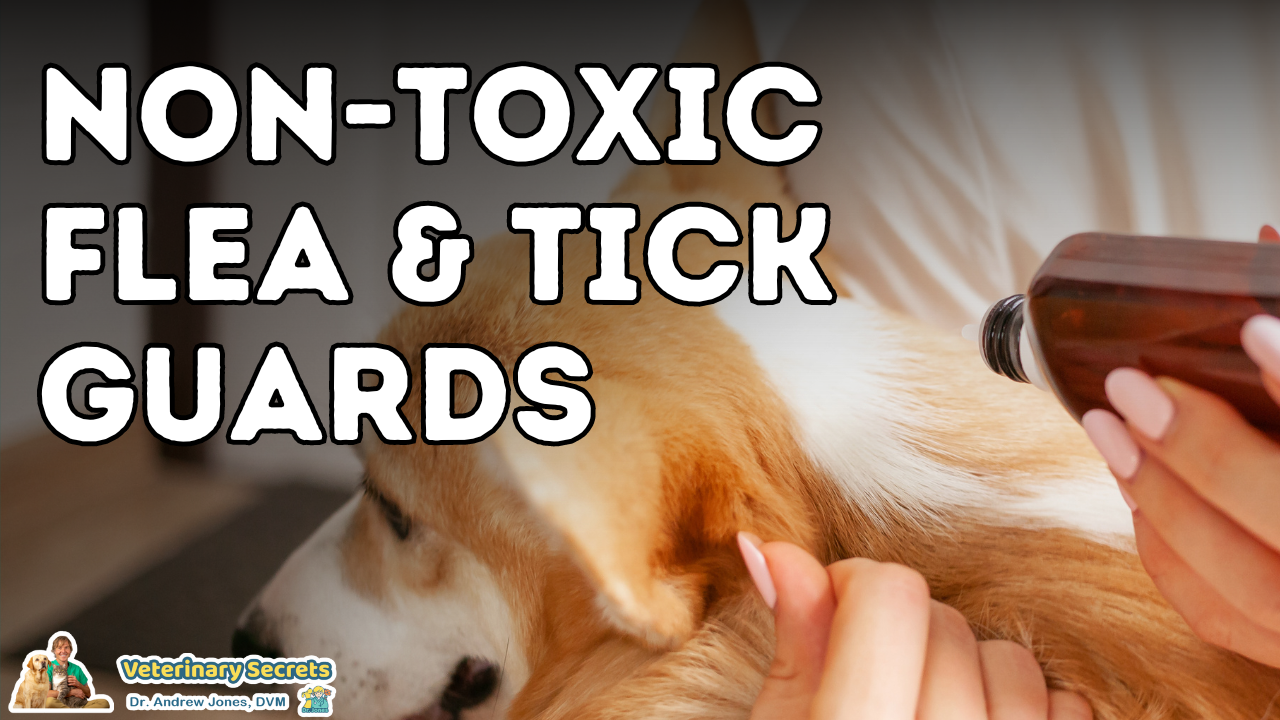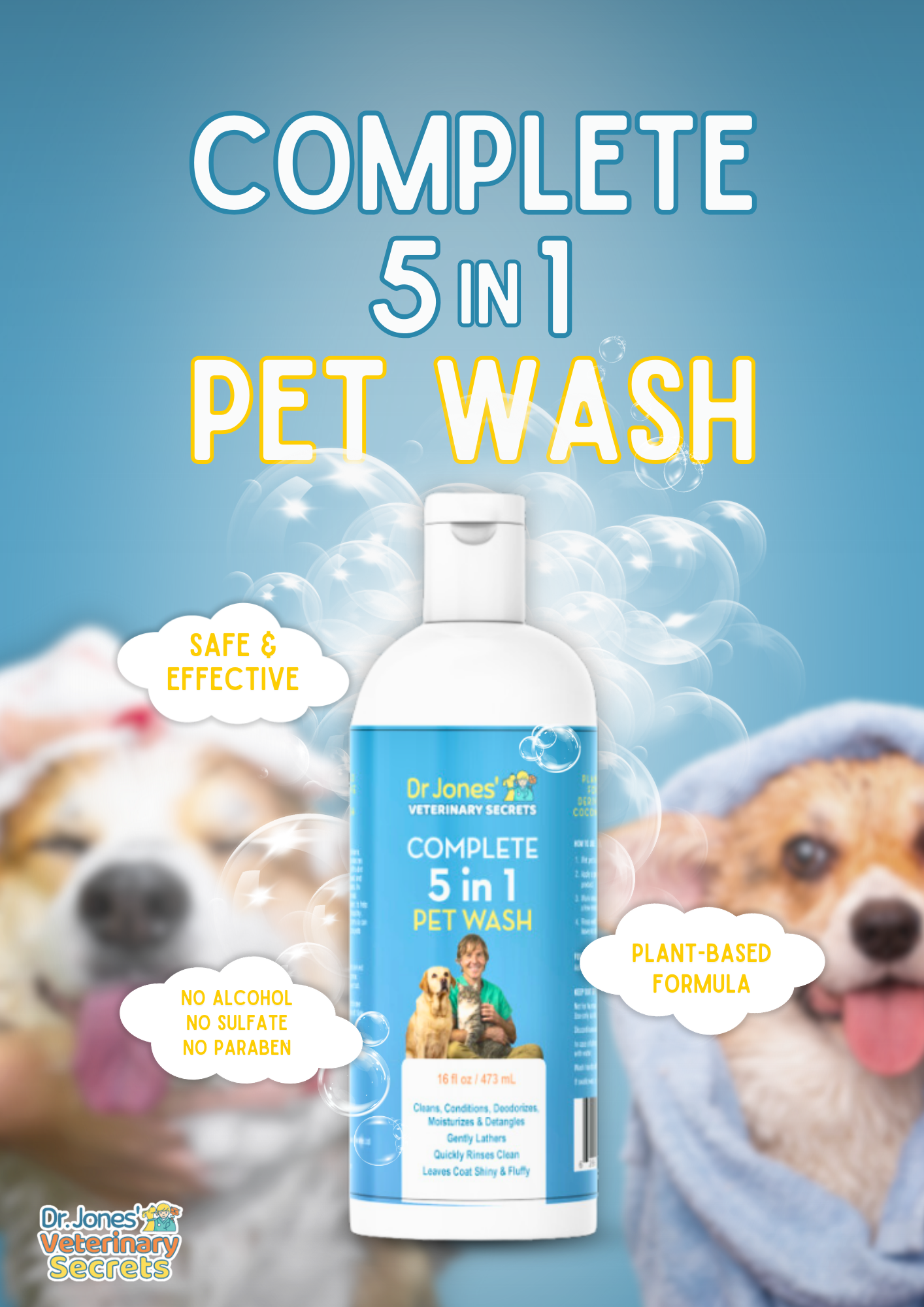Non-Toxic Flea and Tick Guards, plus Dr. Jones’ new Homemade Flea Spray!

For many pet owners, the thought of using harsh chemicals on their beloved animals is a concerning one. This is why I’m excited to share with you some of the most effective natural strategies I’ve used and recommended over the years to keep these pesky critters at bay.
Today, we’re diving into an often overlooked but vitally important aspect of pet health—natural flea and tick control.
Let’s dive into natural methods that can keep your pets pest-free.
1. Simple Tools and Techniques
Flea Comb: A simple $1 flea comb is your first line of defense. Regular use can help in early detection and removal of fleas, especially from critical areas like the back of the ears, armpits, and groin. It’s not just about detecting fleas; it’s also about preventing their spread and ensuring your pet’s comfort.
2. Natural Repellents
Bad-Smelling Herbs: Herbs like pennyroyal and catnip are not just for your garden; they work wonders in repelling fleas due to their strong aromas. Scientific studies have validated their effectiveness, making them a great natural alternative to chemical repellents.
Chinchilla Dust (Diatomaceous Earth): Safe application of diatomaceous earth on your pets and around your home can be a game-changer. It works by dehydrating the fleas, effectively reducing infestations without harsh chemicals.
3. Environmental Control
Natural Control in Your Yard: Utilizing beneficial nematodes in your yard targets flea larvae and pupae before they can mature into adults, disrupting their life cycle right in your backyard.
Dehumidify: Fleas thrive in humid environments. By using a dehumidifier, you can make your home less hospitable to these pests, thereby breaking their life cycle.
4. Making Your Pet Less Appealing to Pests
Make Your Pet Taste Bad: Natural supplements like garlic and brewer’s yeast can make your pet less appealing to fleas. However, it’s important to use these with caution, especially in cats, to avoid any adverse effects.
5. Essential Oil Sprays
Cedarwood Oil Spray: Cedarwood oil is an excellent natural flea repellent. I recommend using it cautiously, particularly with cats and small dogs, to avoid any sensitivity.
6. Herbal Remedies
Natural Pyrethrins from Feverfew Flowers: Feverfew is not just a pretty plant; it contains natural pyrethrins that are effective flea repellents. I’ll teach you how to harness these flowers to keep your pets safe.
7. Dr. Jones’ Best Ever Natural Flea and Tick Repellent Spray
Ingredients and Benefits:
- Neem Oil: Known for its repellent properties and safety.
- Cedarwood Oil: Effective and safe for use around pets.
- Coconut Oil: Adds anti-inflammatory benefits and enhances repellency.
- Witch Hazel with Aloe: Soothes skin and acts as a mild astringent.
- Castile Soap: Helps emulsify the oils and acts as a gentle flea killer.
Recipe and Application: I’ll provide a step-by-step guide on how to mix these ingredients effectively and safely apply the spray to your pets.
Embracing natural methods for flea and tick prevention not only aligns with a holistic approach to pet health but also reduces the chemical load on their bodies and in our environment. I encourage you to try my homemade flea and tick spray and share your experiences. Together, we can keep our pets healthy and pest-free naturally.


Hi Dr. Jones,
The recipe in the video doesn’t mention Castile soap. How much Castile soap should we add to the Neem Oil recipe?
1 tbsp of castile soap is enough
How much neem oil? When it said diluted I got confused?
Neem oil is used in a 2% dilution, which is considered safe for dogs. To achieve this concentration, you would add 2 milliliters (about 1/2 teaspoon) of neem oil to the mixture.
To prepare the spray, combine the following ingredients:
1/2 cup (125 ml) non-alcoholic witch hazel extract
1/4 cup (60 ml) liquid coconut oil
2 ml (1/2 teaspoon) neem oil
10 drops cedarwood essential oil
10 drops lavender essential oil
Mix all ingredients thoroughly and transfer the solution into a spray bottle. Shake well before each use. Lightly mist your dog’s coat, avoiding sensitive areas like the eyes and mouth. For dogs, apply the spray 2–3 times a week. For cats, use once a week.
If you notice any solidification of the oils due to temperature changes, gently warm the mixture and shake well before reapplying.
Yes I will be trying this recipe for flea prevention.
Thank you , it’s criminal what the vets are prescribing with all the adverse effects ,& deaths of animals .
Hello. Do you mix any water with this or just exactly as you listed and maybe a little Castile soap added to it? I couldn’t find the directions, I just found the ingredient list. Thank you.
Just the ingredients
He has a video on Youtube with the recipe.
Is this flea and tick spray safe for cats?
Yes it is
Can you provide a brand of non alcohol Witch Hazel? I am finding so many of them are toners.
For pets, try Thayers Alcohol-Free Witch Hazel (unscented) or Dickinson’s Alcohol-Free Witch Hazel Toner. Both are safe for pets when used properly (avoid eyes/mouth). Always patch-test first!
First I want to say Thank you for helping US take care our pets. Need to ask how much Castile Soap? Does it come in a powder? I just know it as soap bar. So shave some off the bar? Thanks Again Doc. MaryAnn
Use 1 tablespoon (15 ml) of Castile soap. This amount helps emulsify the oils and acts as a gentle flea killer. If you’re using a bar of Castile soap, grate or shave about 1 tablespoon’s worth to match the liquid measurement. Ensure the soap is unscented and free from additives.
Is the shampoo you show for ticks/fleas ? The 5 in 1 shampoo
Yes, the “Complete 5?in?1 Pet Wash” is formulated as a natural flea and tick shampoo. It’s an all?natural formula — free from alcohol, sulfates, parabens, MEA or DEA — and is both a shampoo and conditioner that moisturizes and helps lock in water. A great choice for allergic pets, helping to cleanse and soothe while also offering protection against fleas and ticks
I’m going to make this for my dog. I’m also wondering if my human family and I can use it as well.
Yes, you and your family can use Dr. Jones’ homemade flea spray, but with some important precautions.
The spray contains ingredients like neem oil, cedarwood essential oil, and lavender essential oil, which are generally safe for pets when diluted properly. However, these ingredients can be potent and may cause skin irritation or allergic reactions in some individuals. It’s crucial to perform a patch test before widespread use. Apply a small amount of the spray to a discreet area of your skin and wait 24 hours to check for any adverse reactions.